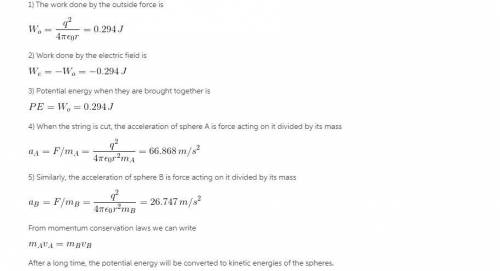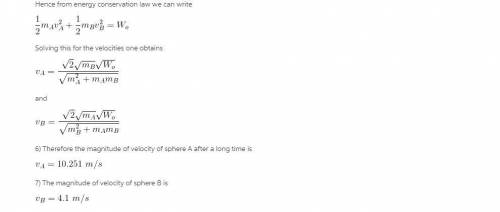
Physics, 28.02.2020 03:28 annadel4547
An outside force, Fo, brings two small metal spheres, A and B, at rest from a long distance away to a point where they are 1 meters apart. They are then connected by a non-conducting string of negligible mass. The spheres have mass mA = 5.8 g and mB = 9.5 g and both have equal positive charges of 5 μC. (You may assume the length of the string is much greater than the radii of the spheres.)
1)What was the total work done by the outside force to bring the spheres to the point described?
2)What was the total work done by the electric field when the two sphere were brought together as described?
3)What is the potential energy of the two sphere system after they have been brought together as described? (You may assume the spheres had zero potential energy when they were a long distance apart.)
4)Suppose you cut the string. At that instant, what is the magnitude of the acceleration of sphere A?
5)At that instant, what is the magnitude of the acceleration of sphere B?
6)After a very long time, what is the magnitude of the velocity of sphere A?
7)After a very long time, what is the magnitude of the velocity of sphere B?

Answers: 3


Other questions on the subject: Physics

Physics, 21.06.2019 21:00, caitybugking
Which type of circuit is becoming more common in residential electrical design and construction? a. hazardous-area circuit b. three-phase circuit c. 480-volt circuit d. communication circuit
Answers: 1

Physics, 21.06.2019 21:50, yairreyes01
Adiver in midair has an angular velocity of 6.0 rad/s and a moment of inertia of 1.2 kg·m2. he then pulls is arms and legs into a tuck position and his angular velocity increases to 12 rad/s. the net external torque acting on the diver is zero. what is his moment of inertia in the tuck position?
Answers: 1

Physics, 22.06.2019 11:20, ashtonbillups
More solar radiation is absorbed by earth’s surface than by
Answers: 1

Physics, 22.06.2019 13:00, help1572
Aplayground merry-go-round has a radius of 4.6 m and a moment of inertia of 200 kg-m2 and turns with negligible friction about a vertical axle through its center. a child applies a 26.0 n force tangentially to the edge of the merry-go-round for 15.0 seconds. if the merry-go-round is initially at rest, how much work did the child do on the merry-go-round?
Answers: 1
You know the right answer?
An outside force, Fo, brings two small metal spheres, A and B, at rest from a long distance away to...
Questions in other subjects:



Mathematics, 26.12.2020 06:30

Mathematics, 26.12.2020 06:30

History, 26.12.2020 06:30

Computers and Technology, 26.12.2020 06:30


Chemistry, 26.12.2020 06:30


English, 26.12.2020 06:30






 \
\




